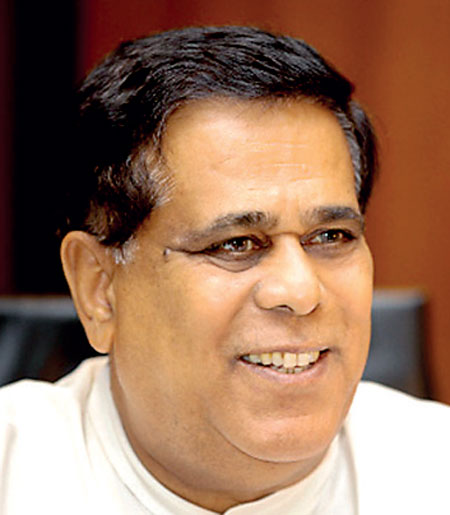Wednesday Jan 07, 2026
Wednesday Jan 07, 2026
Monday, 14 February 2022 01:05 - - {{hitsCtrl.values.hits}}

President Gotabaya Rajapaksa

Prime Minister Mahinda Rajapaksa

Finance Minister Basil Rajapaksa

Labour Minister Nimal Siripala de Silva

Treasury Secretary S.R. Attygalle
|
 A surcharge tax to fill depleted Government coffers
A surcharge tax to fill depleted Government coffers
Finance Minister Basil Rajapaksa, known popularly as Basil, made the announcement in the Budget 2022 that the Government will impose a tax surcharge of 25% on those companies and individuals whose taxable income in the tax year of 2020/21 amounted to Rs. 2 billion or more. It was to be a one-time tax payable by 62 high value taxpayers in 2022. The objective of this special tax was to raise the necessary revenue to finance the Government expenditure programs for the year undisturbed.
The amount to be raised by way of this special tax was Rs. 100 billion or 0.5% of the estimated GDP of the year. When this was announced, based on the announced profits of companies listed in the Colombo Stock Exchange, it was pointed out that the impact on those companies falling within the definition will be around Rs. 50-60 billion. What this meant was that Basil’s target was an easy cakewalk.
Surcharge taxes are not new
Sri Lanka had imposed similar tax surcharges from time to time since 1961 to boost the Government coffers when the revenue fell short of the planned expenditure programs. But they were all across the board surcharges payable by all taxpayers without specifying a particular threshold of application. Such across the board surcharges are a better way to recoup revenue losses instead of resorting to borrow from the banking sector, especially the Central Bank, which is considered highly inflationary.
The 3rd century economics Guru, Kautilya, recommended in his treatise on economics, The Arthashastra, that the king can make special levies on citizens when his Treasury runs low. They were across the board levies imposed on farmers, merchants, craftsmen, professionals, and livestock owners; the key personnel who had been engaged in economic activities during that period. In addition, a recommendation was made to collect voluntary contributions from the rich and expropriate the assets owned by the temples. As such, the sovereign kings were expected to fill their coffers by special tax levies.
|
Basil, victim of an attractive tax concession package
Basil had been forced to go for this extraordinary measure of filling the Government coffers because the Gotabaya Rajapaksa administration had made a serious policy error when it announced an unsolicited, attractive tax concession to income taxpayers and value-added taxpayers. When this was announced in the President’s election manifesto in November, 2019, I wrote in this series in December 2019 that the new Government should not implement it because it will make a serious dent on the revenue base of the Government (available at: https://www.ft.lk/columns/Tax-cuts-Control-the-damage-before-the-unconventional-stimulus-backfires/4-691207).
In this article, I argued that the estimated revenue loss would be around Rs. 650-80 billion or 4% of GDP which could not be afforded by the Government at that time. This was before the outbreak of the COVID-19 pandemic. The actual loss compared to the actual tax revenue of 2019 was Rs. 516 billion. However, had the old tax regime remained in force and the Inland Revenue had realised the targeted revenue of 13% of GDP, the loss in the potential revenue by the Government in 2020 had amounted to Rs. 600 billion. This is 4% of GDP. The potential revenue loss during 2021, 2022, and 2023 will also be around 4% of GDP and this is a serious dent in the revenue base of the Government.
Sound advice not acceded to
Because of the constrained fiscal space in the face of COVID-19 pandemic, I wrote in May 2020 that the Government should consider the postponement of the costly tax concessionary package introduced in November 2019 (available at: https://www.ft.lk/columns/Constrained-fiscal-space-for-post-COVID-19-reconstruction-Consider-postponing-costly-tax-reforms/4-700327). Since the revenue loss is unaffordable, I argued that the Government should not try to introduce these tax reforms when the country was facing a serious economic slowdown due to the pandemic. Hence, reforms should be tried out in normal situations.
My concluding recommendation to the Government was the following: “Even after the expected approval of a formal budget by the new Parliament, the Government will continue to suffer from this handicap due to its low revenue base. It will not be able to meet its financial obligations unless it borrows heavily from the local and foreign markets. Both would worsen the country’s debt situation pushing it further down to an inescapable debt trap. This has to be avoided at all costs. Given these circumstances, it will be prudent for the Government to postpone its generous tax reforms until the country returns to normalcy.”
Historic increase in borrowing from banks and in money stock
This was not heeded to, and the way-out for the Government was to resort to the banking sector for financing the budget. Accordingly, during 2020 and 2021, the Government had borrowed from the banking sector, that is, the Central Bank and commercial banks, a net sum of Rs. 3,500 billion marking an increase by 125%. This is a colossal sum. Accordingly, the total money stock in the country had expanded during this period by Rs. 3,023 billion or 40%. The unintended consequence of this extraordinary money growth was the building of inflationary pressure in the domestic economy, on one side, and depletion of foreign reserves putting pressure for the rupee to depreciate in the market, on the other.
Already inflation has accelerated to 14%, while rupee is now traded in the unofficial market between Rs. 250-260 per dollar when the artificially maintained official rate is just Rs. 200 per dollar. These two numbers are worsening day by day jeopardising Basil’s budget targets.
|
Surcharge: Is it really a tax on the super-rich?
When Basil became Finance Minister in July 2021, I pointed out to him in another article in this series that among the serious challenges he had to face, one was the continuation of the costly tax concession introduced by his predecessor (available at: https://www.ft.lk/columns/Challenge-before-the-new-Finance-Minister-Choice-between-pragmatism-and-dogmatic-ideals/4-72028). If sanity prevailed on him, I argued that he should consider restoring the tax regime that had prevailed prior to 2019. He was expected to make this announcement in the budget for 2022 presented to Parliament in November 2021.
However, he went for an extraordinary tax measure in the form of levying a surcharge on large taxpayers at 25% if their taxable income in 2020/21 amounted to Rs. 2,000 million or more. Apparently, he would have been advised that this was an easily marketable tax proposal because it is imposed on the super-rich of the country. But what had been ignored is that these super-rich companies employ ordinary citizens of the country and if these companies run into economic difficulties, it is these ordinary citizens who must forgo salary increases and other benefits first, and later their jobs. It also affects those in the labour pool now and are waiting to be employed. The affected companies will cut down new hiring thereby impeding the overall employment growth in the country.
Unwarranted inclusion of provident and pension funds
Now that the bill on surcharge has been gazetted, it has run into storms due to the unintended inclusion of the Employees Provident Fund, Employees Trust Fund, private provident and pension funds, and other superannuation schemes. In the budget speech, Basil clearly said that the target taxpayer group is just 62 high-value taxpayers. There were no indications that provident and pension funds are included in the list. However, the bill has defined a company subject the surcharge is as defined in the Inland Revenue Act.
In the interpretation section 195 of this act, a company for tax payment purposes includes provident, pension, and superannuation funds as well. Hence, by default, EPF and ETF are subject to this tax surcharge. Though no protests have been made about the private provident and pension funds, if they earn a gross income of Rs. 2,000 million or more, they are also subject to the surcharge in question.
EPF is already bleeding of high taxes
The tax treatment of EPF needs further elaboration. When EPF was inaugurated in 1958, its earnings had been exempted from income tax. But later in 1989, the Finance Ministry thought it useful to tax the earnings of the Fund and it was brought under the corporate tax regime. However, the difference between a company and EPF for tax treatment was that EPF was subject to tax on its gross earnings, whereas companies were subject to net earnings. Even the financial institutions which are subject to corporate income tax are paying their tax on the net profits after interest expenses have been deducted from the gross interest income.
In the case of EPF, the original tax rate was 10% of the gross income and this rate was increased to 14% in 2018. As a result, EPF has become the largest corporate taxpayer in the country. For instance, in 2020, EPF had a gross income of Rs. 283.5 billion and at 14%, it may have paid a tax of Rs. 40 billion to the Inland Revenue Department. During that year, the corporate income tax collection amounted to Rs. 214 billion. Thus, EPF had accounted for nearly 20% of this tax collection. EPF has a membership of about 19 million at end-2020. Accordingly, each member is deemed to have paid an income tax of Rs. 2,060 during that year.
|
EPF members are at the receiving end
The surcharge to be introduced in the bill in question must be paid on the income during 2020/1 in two instalments in 2022, the first on or before 31 March and the other on or before 30 June. Based on its income in 2020, it is liable to pay a surcharge tax of Rs. 70 billion. The first instalment of Rs. 35 billion should be paid by 31 March and the balance by 30 June. This means that each EPF member has to pay some Rs. 3,500 as surcharge tax. This has to be charged to the earnings of EPF in 2022. The estimated gross revenue of EPF in 2022 is about Rs. 300 billion. Out of that, EPF has to pay normal income tax of Rs. 42 billion.
Thus, the total payments which EPF should make to Government by way of taxes amount to Rs. 112 billion. This leaves only Rs. 188 billion for distribution to members. It would cause to reduce the potential interest they should get from the Fund by about 4 percentage points. This is a serious blow to EPF members who are already getting a low return on the balances they hold in the Fund. Since EPF is the available superannuation fund for non-pensionable private sector employees, such a reduction in the interest rate is to adversely affect the workers during their retired age. This was not something expected by the original crafters of the EPF law.
Surcharge is bad in taxation
There are some proposals that pension and provident funds should be exempted from the tax surcharge. What this means is that there is no harm in imposing a mega surcharge on other economic entities. This surcharge, in my view, is bad in taxation because it is introduced with retrospective effect. The incomes under reference have already been earned by these entities and utilised for investment and dividend payments. Hence, when a mega size surcharge is imposed on them, to generate liquid cash for tax payments, they will have to dispose of some of the assets in the market or raise a loan by keeping such assets as collateral.
Whatever the course of action they may take, it is an additional cost to these taxpayers. This is specifically relevant to EPF because it does not maintain a mega cash balance of Rs. 35 billion to pay the surcharge. Hence, it will have to dispose some of the Treasury bills and Treasury bonds in the market to pay this surcharge. Since the interest rates have increased in the recent few months, the market prices of securities it is holding have fallen. As such, when they seek to dispose some of them in the market in a hurry, it will have to incur a capital loss which will in turn be passed on to the members. This is like subjecting EPF to a double whammy.
Can this surcharge be repeated after 2022? Certainly no
In my view, instead of going for this mega surcharge, Basil should restore the tax regime that had been in force prior to 2019. It is not a loss of face to admit a policy error. Since with the new tax regime the Government is bound to make continuous potential losses in tax incomes, they will face this problem forever. Suppose Basil has sorted out his problem in 2022 with this surcharge. But what kind of surcharges will he introduce in 2023 and beyond? If the present surcharge is repeated, it will certainly deliver a death blow to Sri Lanka’s large business sector. Hence, it is prudential for him, and for the Gotabaya Rajapaksa administration, to restore the old tax regime and solidify the tax revenue base rather than going for temporary palliatives which cannot be repeated in future years.
He should surely avoid moving from one mistake to another at any cost.
(The writer, a former Deputy Governor of the Central Bank of Sri Lanka, can be reached at [email protected].)